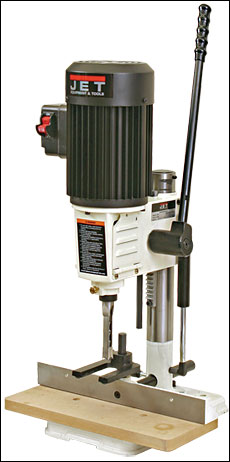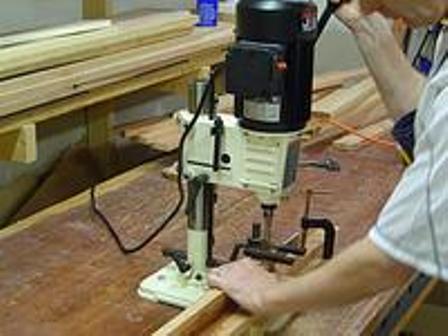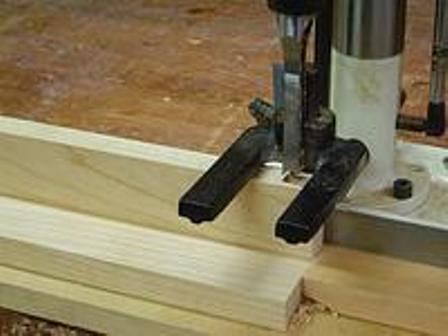After watching Norm Abram effortlessly cut mortises with a hollow chisel mortiser, and reading glowing accounts about them in woodworking mags, I decided it was high time to equip my shop with one of these bad boys. It also happened that I was planning to build several tables with mortise and tenon joinery so this helped my decision to buy. Remember: you can always justify the purchase of a new woodworking tool.

Jet JBM 5 benchtop mortiser
I opted for the Jet JBM-5. This is a popular bench top model that costs under $300. Delta makes a similar machine in the same price range. Compared to industrial strength freestanding mortising machines that can run $1000+, a bench top mortiser makes sense for the small woodshop and is certainly adequate for the occasional mortising task. If you plan to do a lot of mortising, including mortises larger than 3/8″ or so, a freestanding model is probably a better choice.
Setup was quick and painless. It was mostly a matter of screwing a few things in place and wiping off the rust inhibiting coating. For stability, I bolted the machine to an old workbench (you do need to secure the bench top models). Before long, I was churning out mortises…
There’s a certain pleasure to “hogging out” mortises with a hollow chisel mortiser. Slide the board in position, pull down the handle, and watch the wood chips fly out the ejection port as a nice square hole appears in the wood. Slide the board over the width of the chisel and cut an adjacent hole. And so on, and so on until a mortise of the desired width is formed. No whining router or fine sawdust flying in all directions. That’s about as close to Nirvana as one can get in the woodshop.
How it Works
Hollow chisel mortising machines are essentially specialized drill presses for boring square, rather than round, holes. This is accomplished via a square hollow chisel with an auger bit inside it. The auger drills out most of the material and the chisel shears off the remaining stuff on the sides. The resulting cut-out is not as smooth as that produced by a router bit but it’s fast and doesn’t spew out saw dust at high speed. Another advantage is that the chisel produces square corners so there’s no need to round off the edges of the tenons. As you might suspect, the system works best when the chisel and auger are kept sharp.

Jet JBM-5 benchtop mortiser in action
The Jet machine employs a hold-down fork to keep the board in place when raising the chisel from the just-cut hole. Without this hold-down, it would be quite challenging to remove the chisel, especially on the first cut. I found that the device worked fairly well although the chisel would sometimes bind on the upstroke if the fork wasn’t firmly pushed down against the board. But if the fork is too tight against the board, it’s difficult to slide it sideways to cut the next hole. It’s a bit of a balancing act…
A couple gotchas
After cutting perhaps a dozen mortises, the chisel emitted a high pitched screeching noise as soon as the power was turned on. Others have encountered this “screaming chisel” phenomenon which is reportedly due to pitch buildup at the end of the auger bit. A suggested solution is to lower the bit slightly below the chisel to open the gap between the bit and chisel but I haven’t yet tried this out. Honing the bit’s mating surface is supposed to help also.
I didn’t much care for the design of the adjustable fence because it makes it tricky to center the mortise in the wood. The fence is attached to a sliding piece of steel that gets locked in place with a set screw. To adjust, you tap the bar forward or backward, tighten the screw, make a cut, etc. After a little trial and error, it is possible to get the mortises centered so this isn’t a deal breaker.

Mortiser hold down fork
It requires a fair amount of effort to plunge the chisel into the wood for the first cut. If the handle was longer (more leverage) or the motor more powerful, I suspect the cut would go much smoother. Fortunately, subsequent adjacent holes are much easier to cut because the chisel only has to cut on three sides.
In summary…
For the money, the Jet JBM-5 hollow chisel mortiser is a decent machine. It produces less noise and dust than a router-based mortising setup and produces square cornered mortises so there’s no need to round the tenons. That’s a definite time saver. I did have a few gripes such as the screeching noise and the low budget fence but these are manageable issues. If I made a lot of furniture with mortise and tenon joinery, I would likely opt for a more powerful freestanding mortiser. However, the Jet JBM-5 is more than adequate for my occasional mortising needs and I would recommend it to anyone else in a similar situation.

